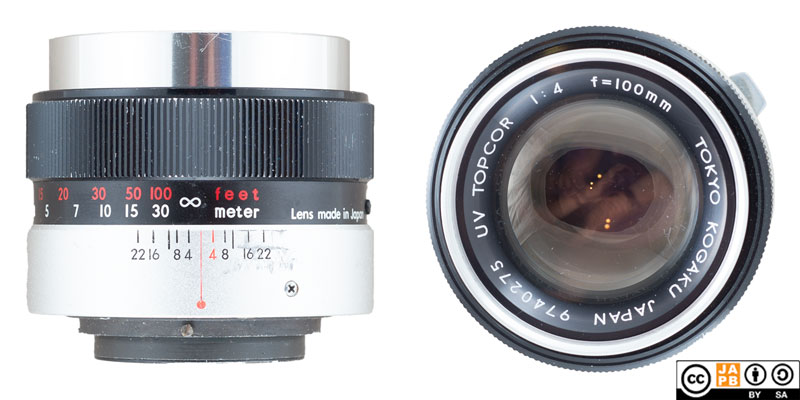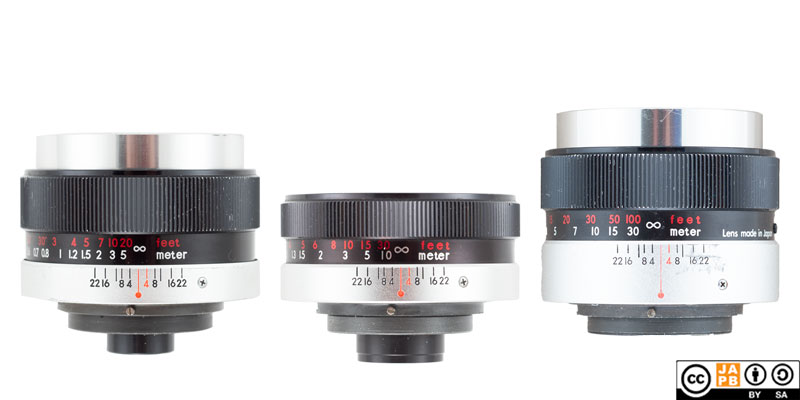Pekka Buttler, 08/2024

Specifications
The table below summarizes the lens’ key specifications (measurements based on pictured, last version of the lens):
| Brand: | Tokyo Kogaku (Topcon) | Lens name | UV TOPCOR 1:4 f=100mm |
| Focal length(s)1 | 100 mm | Angle-of-view2 | 24,4 ° |
| Maximum Aperture | f/4 | In Production | 1963–1976 |
| Lens mount (this lens) | Topcon UV | Generation | Topcon UV |
| Length3 | 46,2 mm (from flange) 54,2 mm (entire length) | Diameter4 | 59,2 mm |
| Filter ring diameter | 49 mm | Weight | 184 grams |
| Lens element count | 5 | Lens group count | 5 |
| Aperture blades (S/R/C)5 | 5 S | Focus throw | 250 ° |
| Minimum focusing distance | 1,5 m | Maximum magnification | 1:12,9 |
| Has manual aperture ring | NO | Has Manual focus ring | YES |
| Aperture mechanism type | N/A | Aperture click stops | N/A |
Further notes:
• When Topcon introduced the UV system with the Wink Mirror S in 1963, the system initially offered three lenses: A 35 mm f/3.5 [data sheet] moderate wide angle lens, a 53 mm f/2 [data sheet] standard lens, and a 100 mm f/4 short tele lens (this lens).

• Topcon UV 35 mm f/3.5
• Topcon UV 53 mm f/2
• Topcon UV 100 mm f/4
• This 100 mm f/4 lens is interesting in that it is small and light, especially for a tele lens.
• This design was never replaced with a newer design, and remained available until the bitter end, making one of the most long-lived Topcon lenses. On the other hand, it never had the most attractive specifications and seems to be quite rare today. The fact that it was nevertheless kept in the lineup indicates that it had a loyal following.
• As with all Topcon UV lenses, this lens lacks an aperture ring (aperture was controlled on the camera). This has some implications for adapting (see below)
• The filter threads do not rotate on focusing.
Versions and variations
The 100 mm f/4 Topcon UV lens was introduced together with Wink Mirror S camera in 1963 and was never replaced with a newer design during the entire lifespan of the Topcon UV system (1963–1978).
Having studied images of 20+ samples of this lens, I see no indication whatsoever that the lens had been modernised, updated or tweaked during that entire time. Moreover, it seems every copy was produced using the silver-black color scheme (see image above).
History of Topcon
Unless you know your camera lore, you might not know that Topcon was once – between 1957 and 1976 – one of the foremost camera companies in the world.
You can read more details in the Topcon company profile.
Adapting
Adapting Topcon UV lenses is not especially easy, but this is not so much due to the lens mount. Technically the Topcon UV mount is very much like the DKL mount, and adapters for the DKL mount have existed for ages. Moreover, the Topcon UV mount offers a generous flange focal distance, making it relatively easy to manufacture adapters, even to SLR mounts.
The real reason why adapting Topcon UV lenses is relatively difficult is the simple weak availability of suitable adapters. It seems practically no-one bothered manufacturing adapters to allow the use of Topcon UV lenses on SLRs, and even with today’s most popular mirrorless mounts, you have to dig deep into aliexpress to find a metal adapter from Topcon UV to Sony FE/NEX (eBay has some 3D printed adapters).
(Remember that because Topcon UV lenses lack an aperture ring, that is a functionality that the adapter must supply.)
With these limitations in mind, below are (in the current state of affairs) the situation for adapting Topcon UV lenses.
This lens cannot be used natively on any current SLR or dSLRs. To use it in its native environment, you will need a Topcon UV (Wink Mirror S, Uni, Unirex/Unirex EE, IC-1 auto or new IC-1 auto) film body. While these were never produced in immense numbers, they seem to have stood the test of time reasonably well, and can still be found in a functioning condition.
While Topcon UV lenses are manual focus lenses, they lack an aperture ring. Hence, to adapt a Topcon UV lens to a mirrorless camera, you need an adapter that not only offers the correct mounting system and flange focal distance, but also allows you to control the Topcon UV lens’ aperture mechanism. As noted above, such adapters are available, but their availability is surprisingly weak. No special adapters (helicoid adapters, tilt/shift adapters) are currently available.
Using Topcon UV mount lenses on an SLR/dSLRs could be an option (there are no physical reasons why the mount could not be adapted), and Topcon themselves used to offer an adapter allowing the mounting of Topcon UV lenses on Topcon RE cameras. However, it seems that there are currently no adapters available. Moreover, as the rearmost element of many Topcon UV lenses protrudes significantly beyond the flange, it is not inconceivable that some Topcon UV lenses would (assuming there was an adapter) risk colliding with the mirrors on some dSLRs.
Footnotes
- Focal length is (unless stated otherwise) given in absolute terms, and not in Full-frame equivalent. For an understanding of whether the lens is wide/tele, see ‘Angle-of-view’. ↩︎
- Picture angle is given in degrees (based on manufacturers’ specs) and concerns the diagonal picture angle. Rule of thumb:
> 90 ° ==> Ultra-wide-angle
70–90 ° ==> Wide-angle
50–70 ° ==> Moderate wide-angle
40–50 ° ==> ‘Standard’ or ‘normal’ lens
20–40 ° ==> Short tele lens
10-20 ° ==> Tele lens
5-10 ° ==> Long tele lens
< 5 ° ==> Ultra-tele lens ↩︎ - Length is given from the mount flange to the front of lens at infinity. ↩︎
- Diameter excludes protrusions such as rabbit ears or stop-down levers. ↩︎
- S=straight; R=rounded; C=(almost)circular at all apertures. ↩︎